Reversible transitions between noradrenergic and mesenchymal tumor identities define cell plasticity in neuroblastoma
In addition to the mutations observed at the genetic level, other mechanisms related to the epigenetic states of tumor cells may be involved in tumor phenotype and response to treatment. Through the characterization of the super-enhancer and transcriptomic landscapes of neuroblastoma cell lines and human neural crest cells, Isabelle Janoueix-Lerosey’s team previously uncovered two distinct cell identities (Boeva et al, Nat Genet., 2017). Cells of the two identities, called NORadrenergic and MESenchymal, showed notable differences in their behavior in vitro, particularly in terms of chemotherapy resistance and migration abilities.
In several neuroblastoma models, we have now documented spontaneous and reversible plasticity between the two identities, associated with epigenetic reprogramming. Our data revealed that intrinsic factors and signals from the microenvironment dictate cell identity in this pediatric cancer. The analysis of a cohort of 18 patient biopsies and a series of 15 neuroblastoma PDX models by single-cell transcriptomics indicated that most tumor cells exhibited a NOR identity; yet, in several cases a subpopulation of NOR tumor cells presented with MES features that are shared with the analyzed cellular models, indicating that the plasticity described in these models has relevance in neuroblastoma patients (Thirant et al, Nat Commun., 2023).

Figure 2. IC-pPDXC-63 is an original model of phenotypic heterogeneity including noradrenergic and mesenchymal tumor identities.
NOR = noradrenergic, MES = mesenchymal. (A) Ex vivo culture of the noradrenergic IC-pPDX-63 neuroblastoma model established from a brain metastasis of a stage 4 case at relapse resulted in the IC-pPDXC-63 cell line that includes floating neurospheres and adherent cells as observed by contrast phase microscopy. (B) Heatmap and unsupervised clustering of samples (cell lines, patient tumors and PDXs) using the expression of transcription factors (TFs) of the noradrenergic and mesenchymal identities 17,18 on bulk RNAseq data. The transcriptomic profile of the IC-pPDX-63 model (bulk RNAseq of the PDX tumor (PDX) or from its single-cell (scPDX)) and its derived-cell line (CL_IC-pPDXC-63) are noradrenergic and highly similar to that of the matched patient tumor (IC-63) from which it has been generated. Two replicates of CD44pos and CD44neg cell sorts of the cell line are included (a and b). CL = cell line, flo = floating neurospheres; adh = adherent cells. hNCC = human neural crest cells. Source data are provided as a Source Data file. (C) Single-cell transcriptomic analyses of the IC-pPDXC-63 cell line by Seurat showing clustering at resolution 0.8, cell cycle phases, and the noradrenergic and mesenchymal identities highlighted by noradrenergic and mesenchymal transcription factor signatures 17,18 and PHOX2B and CD44 expression, respectively, plus a bridge in-between.
